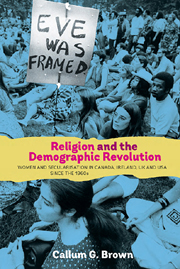 Religion and the Demographic Revolution
Religion and the Demographic Revolution 5 - Family and religion
Published online by Cambridge University Press: 05 April 2013
Summary
Introduction
Underlying most demographic change are people making individual decisions relating to family. The decisions may be planned or spur of the moment, with or without aforethought. The principal decisions are: at what age to have sex, with whom to have sex, how many sexual partners to take, whether to have sex before marriage, whether to get married at all, whether to get married by religious rites, whether to cohabit (either prior to or instead of marriage), what if any contraceptive method to deploy, whether to have an abortion or carry a pregnancy to term, at what age to give birth, how many children to have, and whether to sustain unhappy marriages or get divorced. There are other decisions that spin off from these: whether to delay births and marriage to get higher education, to work and start a career, or not to have children at all for economic reasons. With the exception of illness and death, all of these major features of demography rested heavily on women's choices. Though female decisions may be mediated by male partners, women's personal desires embedded in cultural expectations carry disproportionate weight in most measures of population change.
- Type
- Chapter
- Information
- Religion and the Demographic RevolutionWomen and Secularisation in Canada, Ireland, UK and USA since the 1960s, pp. 172 - 216Publisher: Boydell & BrewerPrint publication year: 2012


